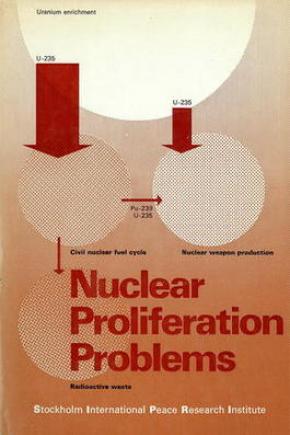Nuclear Proliferation Problems
It is often argued that the danger of the proliferation of nuclear weapons will be greatly increased if the present trends in the development of uranium enrichment technology and in the greater use of fast breeder reactors continue. As time passes, the number of states acquiring the technical expertise and knowledge and the fissile material necessary for the production of nuclear weapons will grow.
It was to reduce the danger of nuclear-weapon proliferation that the Treaty on the Non-Proliferation of Nuclear Weapons was negotiated. The treaty entered into force in March 1970, and article VIII(3) states that: 'Five years after the entry into force of this Treaty, a conference of Parties to the Treaty shall be held in Geneva, Switzerland, in order to review the operation of this Treaty with a view to assuring that the purposes of the Preamble and the provisions of the Treaty are being realized'. This Review Conference will be a crucial event in the field of arms control and disarmament.
In order to discuss the problems likely to be raised at the Review Conference, and to make proposals for consideration at the conference, SIPRI organized, in June 1973, a meeting of a group of leading experts from 13 countries. This volume contains the papers presented at this meeting and an analysis of some of the major military and security consequences of the worldwide spread of peaceful nuclear technology.
Part I. Nuclear technology
1. Introduction
2. A projection of nuclear power and its associated industry
B. I. Spinrad
3. Fast breeder reactors
B. M. Jasani
4. Uranium enrichment technologies and the demand for enriched uranium
P. Boskma
5. Nuclear fuel fabrication plants
B. M. Jasani
6. Nuclear fuel reprocessing plants
B. M. Jasani
7. Uranium enrichment and the proliferation of nuclear weapons
P. Boskma
8. Nuclear weapon technology
J. C. Hopkins
9. Nuclear miniweapons and low-yield nuclear weapons which use reactor-grade plutonium: Their effect on the durability of the NPT
J. K. Miettinen
Part II. The NPT safeguards
1. Introduction
2. The IAEA's NPT safeguards—national control and international safeguards
R. Rainer and B. Sanders
3. NPT safeguards
W. Häfele
4. Arguments for extended NPT safeguards
J. Prawitz
5. Nongovernmental nuclear weapon proliferation
M. Willrich
6. Nuclear power: A Trojan horse for terrorists
D. Krieger
Part III. Cooperation in the peaceful applications of nuclear energy
1. Introduction
2. The non-proliferation of nuclear weapons and the security of the non-nuclear states
A. N. Kaliadin
3. The UN Security Council resolution of 19 June 1968 and the security of non-nuclear-weapon states
J. Goldblat
4. Italy and the nuclear option
F. Calogero
5. The Non-Proliferation Treaty: The Japanese attitude three years after signing
R. Imai
6. Indian attitudes towards the NPT
K. Subrahmanyam
7. Israel's attitude towards the NPT
S. Flapan
8. European security and the Non-Proliferation Treaty
J. K. Miettinen
Appendix. Text of the Treaty on the Non-Proliferation of Nuclear Weapons

